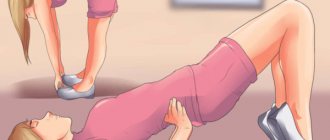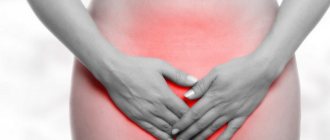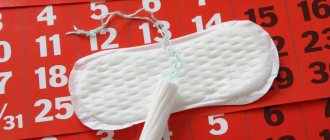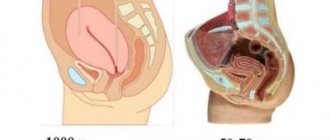During 9 months of pregnancy, the uterus increases in size by more than 500 times, and after childbirth it gradually returns to its previous state. This organ undergoes the greatest changes compared to the entire woman’s body. But all this does not happen in one day.
Immediately after the expulsion of the placenta in the postpartum period, the uterus begins to contract, decreasing in size. In this process, it is cleansed of blood and remnants of the child's place. In different women, the return of the uterus to its previous state occurs differently and may take different time periods. In addition, there are a number of factors that promote or prevent faster uterine contractions. In particular, everyone knows that when a baby sucks the breast, the woman’s body releases the hormone oxytocin, which tones the uterus, enhancing its contractile activity.
On average, it takes 1.5-2.5 months for the uterus to return to its pre-pregnancy size. The uterus contracts most actively in the first days after birth, losing about half of its weight in the first week. This process is accompanied by cramping pain in the lower abdomen, which is more pronounced and intense after repeated births. But it happens that the uterus does not contract after childbirth or contracts very slowly. More precisely, it is the reduced ability of the uterus to contract (hypotony of the uterus) that most often occurs, and complete paralysis of the uterine muscles (atony) is less common.
Hypotension is potentially dangerous for a woman, as it causes postpartum hemorrhage and a number of other complications.
What does the uterus look like after childbirth? Dimensions of the uterus after childbirth
After the baby is born and the placenta is expelled, the woman enters a difficult postpartum period.
The uterus of a non-pregnant woman.
IMPORTANT: Normally, a woman’s postpartum period lasts from 6 to 8 weeks.
The uterus of a woman 9 months pregnant.
You can see how much the organ has enlarged. During the nine months of her “interesting situation,” multiple complex changes occurred in her body. In particular, the uterus grew, gained weight, stretched, and rose. And now that the pregnancy is over, its involution begins.
IMPORTANT: Involution of the uterus is the return of the organ to its place in the pelvic cavity and to its normal size.
The uterus of a woman who has just given birth looks like this:
- Organ size – approximately 38 cm by 24 cm, transverse dimension – 25 cm
- The weight of the uterus immediately after birth is 1-1.5 kg
- The volume of the organ cavity is about 5000 ml
- The fundus of the uterus is located approximately between the womb and the navel of a woman
- Inside the organ there is a continuous open wound, the most damaged area is the one where the placenta was attached
- Remnants of the fetal bladder and thickened blood may remain inside the uterus
- Cervical diameter – 10-14 cm
When medical attention is needed
If a woman experiences weak contractions of the uterus, then drug treatment is indicated for her. Cleaning is often required to mechanically remove any remaining placenta or blood clot. The procedure is performed under local anesthesia and is practically not felt by the woman. After 2-3 hours she is allowed to go home.
After cleaning, the young mother can return to a full life. Of course, you shouldn’t start dealing with the mess right away. It is necessary to spend several days at rest so that the body can rest from the next stress suffered.
More often, uterine contractions are enhanced with special preparations containing a large dose of oxytocin. They are not contraindicated during lactation and do not have a negative effect on the child. The drugs are administered intramuscularly until the uterus is completely restored.
It is not difficult to determine that you need specialist help. If a woman experiences severe bleeding, in which the pad is not enough for one hour, then she should immediately call an ambulance. The woman in labor will be taken to the hospital, where she will undergo an ultrasound examination, tests and a visual examination.
First aid is aimed at stopping bleeding. If the blood loss is severe, a blood transfusion may be required to save the woman's life. Further treatment depends on the reasons that caused the postpartum complication and is aimed at restoring contractile activity. As a rule, a woman spends about 10 days in a hospital, after which drug therapy at home is indicated.
Contraction of the uterus is an important process that should accompany every woman in labor. If abnormalities occur in the body, the woman faces complications. Timely consultation with a specialist and observation by a gynecologist during the first two weeks after birth will prevent very unpleasant consequences for the body.
How long after childbirth does the uterus contract?
Uterine contractions begin immediately after birth. Their reasons:
- effusion of amniotic fluid
- fetal expulsion
- expulsion of the placenta
- changes in a woman's hormonal levels
During 6-8 weeks of the postpartum period, involution of the uterus occurs.
Over the next few weeks, the uterus will cleanse itself, restore its mucous layer (endometrium), contract and decrease in size.
IMPORTANT: Postpartum contractions of the myometrium (muscular layer of the uterine body) are regulated at different levels: at the level of the central nervous system, humoral (in particular, by the posterior lobe pituitary hormone oxytocin), at the molecular level. What is surprising is that the uterus returns to its “pre-pregnancy” size not by reducing the number of muscle cells, but by reducing their size.
In general, during the postpartum period the uterus changes as follows:
- During the first three days, the organ is cleansed of remnants of the amniotic sac and blood clots. Bloody, rather copious discharge and lochia are observed from the genital tract. The cervix closes and can only allow 1-2 fingers through
- On days 3-5, the lochia become scarcer, lighter and more smeared. They will be like this in the next 3-4 weeks, during which the endometrium is restored. A week after birth, the weight of the uterus is already about 0.5 kg, the size is halved
- Most often after 6 weeks, but sometimes after 8 weeks, the placenta is completely healed. The uterus returns to normal size and is only slightly different from the uterus of a woman who has not given birth. Its dimensions are again 8 cm by 5 cm, weight - from 50 g to 80 g. The cervical canal of a woman who has given birth takes on a slit-like shape
IMPORTANT: How long it takes for the uterus to contract after childbirth is a purely individual question. But it is known that in women who breastfeed, involution occurs faster.
Useful gymnastics
As a preventive measure, a woman can do special gymnastics, which speeds up the recovery process and improves overall well-being. But before starting classes, you need to familiarize yourself with important rules:
- Exercises should begin on the second day after birth and continue until 12 weeks. It would be a good idea to continue exercising to improve your immunity.
- The room should be cool. It is recommended to pre-ventilate the room so that it is not stuffy.
- You need to do the exercises regularly, every day, an hour after meals.
- You should only wear loose clothing that will not restrict movement.
- Pre-feed the child so that he does not ask to eat during classes, and the woman is not bothered by swollen breasts.
The exercises themselves are varied. But most of it should be done on the stomach, which helps to contract the uterus. In this case, you need to slowly raise your legs, then your torso. You can’t do abdominal exercises - you won’t achieve anything other than increased bleeding.
An excellent exercise to improve the contractility of the uterus is walking. In this case, you need to stand up on your full foot.
Why does the uterus contract painfully after childbirth?
IMPORTANT: In the first days after childbirth, and sometimes throughout the entire postpartum period, a woman may feel stretching in her lower abdomen, especially when she is breastfeeding. These are uterine contractions. But if the sensations are very unpleasant and painful, you should consult a doctor. Perhaps the restoration of the uterus after childbirth occurs with pathology.
Unbearable pain during postpartum uterine contractions is an alarm bell.
Such pathologies include:
- accumulation of lochia in the uterine cavity
- infection
- inflammation of the endometrium (endometritis)
- other
Stimulation with folk remedies
- Alcohol tincture of water pepper perfectly stimulates the contractile activity of the uterus.
- A decoction of dried herbs.
- A decoction of shepherd's purse.
- Decoction of dead nettles.
The listed traditional medicines are recommended for use if the uterus does not contract after childbirth, but the discharge remains within normal limits. Consultation with a specialist is advisable, but the herbs listed have virtually no contraindications and are prescribed by gynecologists to speed up the release of placental remnants.
Why doesn't the uterus contract after childbirth?
Obstetricians and gynecologists know situations when, after childbirth, a woman’s uterus contracts more slowly (uterine subinvolution) than expected, or does not contract at all. Thus, slowing down the involution of the uterus is possible for the following reasons:
- multiple pregnancy
- large fruit
- features of the location of the placenta (low attachment)
- complicated pregnancy
- difficult childbirth
- disorders of the nervous and endocrine systems of women
- decreased physical activity of women after childbirth
IMPORTANT: If there are neoplasms or inflammatory processes in the uterus and appendages, the uterus is severely injured during childbirth or there is a bend in it, the woman has impaired blood clotting, and also due to some other circumstances, the uterus may not contract at all.
Prevention of complications
The intensity of uterine contractions in the maternity hospital is monitored by a doctor. After being discharged home, a woman should follow several important rules that will help prevent complications that begin with bleeding.
- Do not lift heavy objects and try to rest more for the first two weeks. Of course, with a small child this is quite problematic, but household responsibilities should be assigned to a spouse or other assistants.
- Carry out regular thorough hygiene of the genitals. If an infection gets into the uterus, which immediately after birth resembles a bleeding wound, contractions may weaken. The body's forces will be aimed at suppressing the source of the disease, and not at removing the remains of the child's place.
- Sanitary pads must be changed every three hours, and they must be made with a natural base. This also applies to underwear. It is unacceptable to wear synthetic panties, which can cause serious complications after childbirth.
- Be sure to process the seams according to the instructions of a specialist.
- Breastfeed your baby for a long time. Lactation causes the uterus to contract, so it should last at least two months.
What to do to make the uterus contract after childbirth?
Early breastfeeding stimulates uterine contractions after childbirth.
To ensure that the uterus contracts well, immediately after childbirth a woman:
- put the baby to the breast to stimulate the production of oxytocin
- put cold on the lower abdomen
- additionally inject oxytocin
In the following days, the woman will be advised to:
- breastfeed the baby
- lie on your stomach
- move more, but as far as your well-being allows
- Avoid overfilling the bladder and bowels
If the uterus contracts slowly, you can promote the process by taking herbal preparations.
You can help the uterus contract using folk remedies, for example, nettle infusion.
RECIPE: Nettle decoction Needed: dry crushed nettle leaves - 3-4 tbsp. spoons, water – 500 ml. Pour boiling water over the nettle and wait for the product to infuse and cool. Drink 100 ml three times a day. RECIPE: Infusion of white claspberry in cold water. Needed: dry claspberry flowers – 2 tbsp. spoons, boiled and cooled water – 500 ml. The flowers are soaked in water overnight, in the morning the infusion is drained through gauze or a sieve, and 100 ml is drunk 4 times a day. RECIPE: Infusion of blood-red geranium in cold water You need: dry blood-red geranium herb - 2 teaspoons, boiled cooled water - 500 ml. The herb is soaked in the evening, and in the morning the infusion is filtered, divided into 4 servings and drunk during the day.
Symptoms of lack of contractile activity
As mentioned earlier, in the first four hours after childbirth, a woman experiences quite heavy bleeding. During the specified period of time, a young mother can lose up to 500 ml of blood. Immediately after the birth of the child, a heating pad with cold water is placed on the woman’s stomach, which helps not only to narrow the blood vessels to stop bleeding, but also to reduce uterine contractions.
Over the next few days, the uterus continues to contract, returning to its pre-delivery size. If this does not happen, then heavy bleeding begins, which causes anemia and even shock. At this stage, the woman requires immediate assistance from specialists to prevent severe blood loss.
The contraction of the uterus in the first few days is felt especially clearly during breastfeeding. At the same time, blood clots are released, which is normal.
Exercises to contract the uterus after childbirth
In order for the muscles of the uterus, pelvic floor and abs to return to normal faster after childbirth, you can start doing exercises after 4 days.
IMPORTANT: Even simple gymnastics during the postpartum period must be obtained from a doctor.
Before gymnastics, it is necessary to breastfeed the child, empty the bladder and intestines (if necessary). You need to perform the exercises smoothly. At the same time, the room should not be too hot.
You can stimulate uterine contractions after childbirth with the help of special gymnastics.
EXERCISE No. 1: The woman lies on her side, her body from the top of her head to her pelvis is a straight line, her knees are slightly bent. The hand that is located below supports the head. The second hand rests on the floor (or bed, this exercise can also be done in bed). As you exhale, resting on your hand, the woman slightly raises her pelvis, lingers in this position for 2 seconds, and then returns to the starting position. The exercise is performed 5 to 20 times on each side. EXERCISE No. 2: For this you will need a fitball. A woman just needs to sit comfortably on it and make circular movements with her pelvis in both directions. EXERCISE No. 3: The woman lies on her back, her hands are on the diaphragm, that is, on the ribs under the chest. As she inhales, slowly and deeply, she draws air into her lungs so that only her chest inflates, not her stomach. The woman exhales through her mouth, while trying to suck in her stomach.
Treatment of a poorly contracting uterus
Treatment often requires surgery -
Poor uterine contraction is one of the postpartum pathologies
cleansing the uterus of blood clots and placenta remnants.
But in most cases, treatment with medications is still used.
Typically, intravenous or intramuscular drugs are prescribed that contain oxytocin, which effectively affects the contractile activity of the reproductive organ.
These medications are not dangerous to the baby and can be used for. In this case, prostaglandins may also be prescribed.
An effective method is considered to be a massage of the uterine fundus, which is done through the abdominal wall from the front.
If a woman in labor experiences severe bleeding, hemostatic drugs are prescribed. In case of severe blood loss, blood transfusion is indicated.
To relieve pain, the doctor prescribes antispasmodics or painkillers. However, it is worth remembering that when breastfeeding a baby, it is advisable to avoid these medications, as they can affect the baby.
It is important for a woman to breastfeed her baby to stimulate uterine contractions. In addition, it is recommended to sleep in a prone position on your stomach.
How do you know if the uterus has contracted after childbirth?
A woman will find out how well the uterus has contracted at her first appointment with a gynecologist, which usually takes place 6 weeks after birth.
The conclusion about how well the uterus has contracted is made by the doctor during an examination 6 weeks after birth.
The doctor feels the woman's abdomen to assess the location, size and consistency of the uterus. Also, she can have an ultrasound, which will show:
- how well the uterine cavity has recovered, are there any blood clots left there?
- Has the uterus contracted enough?
- did any complications arise during the postpartum period?
IMPORTANT: If the birth occurred by cesarean section, the uterus contracts somewhat more slowly. To monitor this process, a woman is recommended to visit a gynecologist within a week after being discharged from the maternity hospital.
How to treat pathology at home
Auxiliary methods in the treatment of this condition
are alternative medicine medications. Remedies that help normalize uterine contractions and relieve inflammation include decoctions of the following medicinal herbs:
- Shepherd's Purse
- Yasnotka
- dead nettle
- Dog-rose fruit
Also an effective medicine is a tincture of water pepper in alcohol.
It is important to know that these funds are considered
Pain in the lower abdomen is a sign of pathology
additional treatments to drug therapy. In addition, their use must be agreed with a specialist.
A few words should be said about the consequences of pathology.
Hypotony of the uterus is fraught with dangerous complications.
The most difficult consequences include paralysis of the muscles of the woman’s reproductive organ. This pathology occurs in rare cases, but its manifestation provokes disastrous consequences.
Other possible complications are also dangerous for women in labor:
- Uterine bleeding
- Anemia
To prevent these complications, it is necessary to follow all the doctor’s instructions and not ignore the symptoms of weak contractions of the uterine muscles.
Watch the educational video:
In this article:
In the first few hours after birth, the woman in labor experiences bleeding, which is a consequence of the release of the baby's place. Under the influence of the uterus, all excess should come out, which normalizes the process of restoration of the female body.
It is the contractile activity of the uterus that doctors observe until discharge from the hospital. And if there are violations, the woman may be hospitalized for further treatment.
Causes of uterine subinvolution
The reasons for delayed uterine contractions may be hormonal disorders, anatomical defects, and infectious agents.
Hormonal disorders
Lack of prolactin , the hormone responsible for milk production. Even in postpartum women who are not breastfeeding, the initial levels of prolactin, the main parental hormone, remain at a fairly high level in the first days of the postpartum period.
The production of prolactin entails an immediate release of oxytocin , a hormone that contracts the muscles of the uterus. Prolactin is produced reflexively when the nipples are irritated. Therefore, in nursing mothers, uterine contractions occur much faster.
Lack of prolactin leads to a decrease in uterine contractility. Central regulation of the cerebral cortex is of great importance. When a child is desired, prolactin production is significantly higher.
Anatomical reasons
Remnants of the placenta attached to the wall of the uterus prevent its contraction . Just as a person cannot move his arm in a cast, the uterus cannot contract completely, constrained by the attached lobule of the placenta.
Blockage of the external os of the cervix, flexion of the uterus and other wisdom relate more to theory. With normal contractility, these factors have no significance. A person exhales air with equal success, regardless of whether he has his own jaw or a false one. Likewise, the contents of the uterus freely leave its cavity when the muscles contract.
Processes occurring during the period of involution
Contraction of the uterus occurs under the influence of the hormone oxytocin. The muscles actively contract, which can be felt as a pulling, aching pain in the lower abdomen. During feeding, pain increases, since lactation stimulates the production of the hormone oxytocin.
After the first birth, abdominal cramps resembled pain during menstruation. It was unpleasant, but tolerable. But after the birth of my second child, the pain was so severe that I had to resort to analgesics a couple of times.
In the maternity hospital, an ultrasound scan of the uterus through the abdominal wall is required on days 2–3. In addition to manual examination, this allows us to identify various abnormalities in the recovery of the organ after childbirth. Normally, ultrasound examination reveals minor blood clots in the upper part of the uterus. The average weight of the uterus is about 750 g, and the dimensions of the uterus are 136–144 mm long and 133–139 mm wide.
The cervix takes longer to recover and no longer takes its previous shape. Immediately after birth, the cervix is dilated by 12 cm. By the end of the 3rd month, the cervix takes a cylindrical shape instead of the conical (prenatal) one, and by the end of the 4th week the pharynx becomes slit-like instead of round. During a caesarean section, the cervix and pharynx are not affected.
You should not be afraid of these changes; they do not cause any physiological inconvenience. This shape of the neck and pharynx will only tell the gynecologist that the body has gone through labor.











